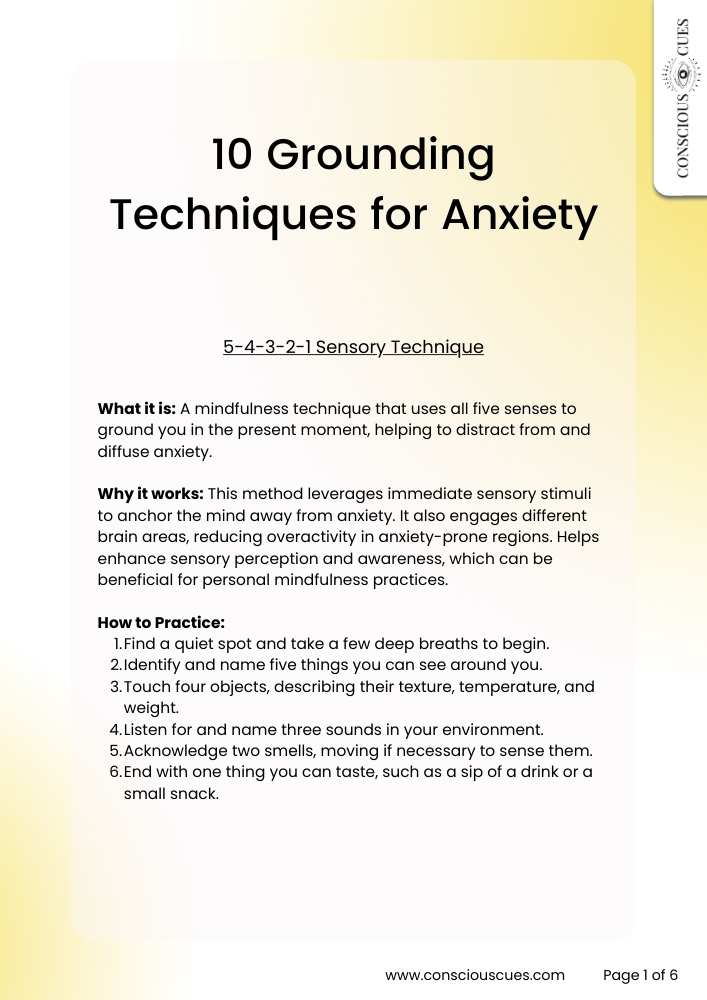10 Grounding Techniques for Anxiety PDF + Audio
These techniques are like a solid ground beneath your feet, steadying you as you master a calm nervous system. These techniques are designed to be versatile and adaptable, allowing for integration into daily routines or use during particularly stressful periods. They can help you address overwhelming emotions, heal from past traumas, and connect deeply with your core self. Whether seeking calm in moments of anxiety or building long-term resilience, this guide offers practical steps to stabilize and enhance your mental well-being.
Listen Now: 5-4-3-2-1 Guided Sensory Experience
Get Your Copy: Grounding Techniques for Anxiety PDF
Grounding Techniques for Anxiety
Grounding techniques offer a practical approach to managing anxiety by helping individuals anchor their awareness in the present moment. These methods are simple yet powerful tools that can be used anywhere and anytime to calm the mind and reduce feelings of stress and overwhelm. Learn more about the science of grounding here.
By focusing on sensory experiences, controlled breathing, or engaging with the environment, grounding techniques help divert attention away from distressing thoughts and bring a sense of peace and stability.
This guide introduces a range of grounding strategies designed to integrate seamlessly into daily routines, providing relief during stressful situations and enhancing overall emotional resilience. Whether you’re new to grounding practices or looking to deepen your existing skills, this guide will equip you with effective techniques to navigate anxiety and maintain emotional balance.
Mastering Anxiety Grounding Techniques: Effective Strategies for Emotional Stability
1. 5-4-3-2-1 Sensory Technique
What it is: A mindfulness technique that uses all five senses to ground you in the present moment, helping to distract from and diffuse anxiety.
Why it works: This method leverages immediate sensory stimuli to anchor the mind away from anxiety. It also engages different brain areas, reducing overactivity in anxiety-prone regions. Helps enhance sensory perception and awareness, which can be beneficial for personal mindfulness practices.
How to Practice:
-
- Find a quiet spot and take a few deep breaths to begin.
- Identify and name five things you can see around you.
- Touch four objects, describing their texture, temperature, and weight.
- Listen for and name three sounds in your environment.
- Acknowledge two smells, moving if necessary to sense them.
- End with one thing you can taste, such as a sip of a drink or a small snack.
2. Deep Breathing Exercises
What it is: A calming practice that involves controlling your breath to stimulate the parasympathetic nervous system and reduce anxiety.
Why it works: Helps regulate the heart rate and breathing, promoting relaxation and reducing physical symptoms of anxiety. Enhances lung capacity and oxygenation of the brain, leading to improved concentration and mental clarity.
How to Practice:
-
- Sit comfortably with your eyes closed to minimize distractions.
- Breathe in deeply through your nose, counting to four slowly.
- Hold your breath for a count of seven.
- Exhale completely through your mouth, counting to eight.
- Repeat this cycle for four to five rounds or until you feel more relaxed.
3. Detailed Object Description
What it is: A mindfulness technique where you focus all your attention on observing and describing an object in detail.
Why it works: Shifts your focus from internal worries to external reality, engaging your mind in a focused task. Develops observation and attention skills which can enhance cognitive abilities outside of anxiety management.
How to Practice:
-
- Choose any object within your vicinity.
- Describe the object’s color, shape, size, texture, and any patterns or details.
- Notice any reflections, shadows, or unique qualities.
- Spend about 5-10 minutes on this exercise to fully engage your attention.
4. Physical Engagement
What it is: Using simple physical exercises to release endorphins and reduce stress hormones.
Why it works: Physical movement increases blood circulation and endorphin levels, boosting mood and distracting from anxious thoughts. Regular physical activity can improve overall physical health and stamina, reducing anxiety long-term.
How to Practice:
-
- Choose an activity suitable for your space, like stretching, walking, or jumping.
- Engage in the activity for at least 10 minutes, focusing on your body’s movements and how they feel.
- Use rhythmic, repetitive actions to help maintain focus and increase calming effects.
5. Mindful Eating
What it is: The practice of consuming food slowly and with full awareness of the eating experience.
Why it works: Focuses the mind on the present task of eating, which can interrupt the cycle of anxious thoughts. Improves digestion and satisfaction with meals, which can positively affect overall health.
How to Practice:
-
- Choose a small portion of food.
- Examine its color, smell, texture, and temperature.
- Take a small bite, chew slowly, and notice every aspect of the flavor and sensation.
- Continue to eat slowly, fully engaging with the experience for the duration of the meal.
6. Visualization
What it is: A relaxation method that involves creating a mental sanctuary to escape the stress of real-life situations.
Why it works: It utilizes the brain’s capacity to imagine calming scenarios, which can decrease the physiological and psychological impacts of stress. Enhances creativity and problem-solving skills by engaging the imagination.
How to Practice:
-
- Find a quiet place where you won’t be disturbed.
- Close your eyes and take a few deep breaths to settle your mind.
- Picture a place where you feel safe and happy. Imagine it in vivid detail—the sights, sounds, and smells.
- Explore this place in your mind for several minutes, allowing the sense of calm to wash over you.
7. Journaling
What it is: A practice of writing down thoughts and emotions to process them more effectively.
Why it works: Helps to clarify thoughts and feelings, reduce emotional intensity, and place abstract concerns into concrete terms. Encourages self-reflection and personal growth over time.
How to Practice:
-
- Choose a quiet time each day for writing in your journal.
- Start by writing about your day, focusing particularly on moments that made you anxious.
- Reflect on the emotions and thoughts you’ve written. This can help identify triggers and patterns in your anxiety.
- Use the journal to propose solutions or steps to manage these stressors.
8. Focusing on a Comfort Object
What it is: The use of a physical object to help focus and calm the mind during moments of anxiety.
Why it works: Provides a tangible focal point that helps draw attention away from distressing thoughts, anchoring it in the physical world. Can be used discreetly in any setting, providing a portable and private form of stress relief.
How to Practice:
-
- Select an object that you find comforting, such as a small stone, a piece of jewelry, or a fabric patch.
- Keep this object with you, especially in situations where you might feel anxious.
- Whenever you feel stress building, hold the object, focus on its texture, temperature, and weight.
- Breathe deeply and allow the object to bring you back to the present moment.
9. Body Scan Meditation
What it is: A mindfulness practice that involves mentally scanning your body for areas of tension and consciously relaxing them.
Why it works: Encourages awareness of the body and helps disconnect from emotional or mental stress by focusing on physical sensations. Improves bodily awareness and can aid in recognizing the early signs of physical stress or discomfort.
How to Practice:
-
- Lie down in a comfortable position or sit in a supportive chair.
- Close your eyes and start by focusing on the sensations in your toes.
- Slowly move your attention up through your body, noting any areas of tightness or discomfort.
- As you identify tension, imagine breathing into that space, relaxing it with each exhale.
10. Engage with Nature
What it is: Using the natural environment to reduce feelings of stress and anxiety through direct interaction.
Why it works: Nature has inherent soothing properties that can reduce blood pressure, enhance mood, and decrease anxiety levels. Provides vitamin D from sunlight exposure, which can have positive effects on mood and overall health.
How to Practice:
-
- Plan regular outings to a park, forest, or body of water.
- While in nature, engage all your senses—listen to the sounds, smell the air, and watch the wildlife.
- Try to disconnect from digital devices during this time to fully embrace the experience.
- Consider incorporating activities like walking, sketching, or photography to deepen your engagement with the natural setting.
Regular Practice of These Calming Techniques Can Improve Your Life
As you’ve discovered throughout this article, grounding techniques are a powerful ally against anxiety.
We’ve explored the profound impact and versatility of grounding techniques in managing anxiety. These methods serve as both a preventative tool and a reactive solution, enabling individuals to regain control during moments of distress and maintain a sense of calm in everyday life. From the tactile engagement of the 5-4-3-2-1 sensory technique to the mental escape offered by visualization, each method is tailored to integrate seamlessly into various aspects of daily routines, enhancing mental resilience and emotional stability.
By embracing these grounding techniques, you can develop a robust toolkit to combat anxiety, fostering not just momentary relief but long-term well-being. Implementing these practices regularly enhances their effectiveness, empowering you to navigate life’s ups and downs with greater ease and confidence. Remember that the journey to managing anxiety is continuous and personal. The techniques discussed provide a foundation upon which you can build a customized approach that resonates with your unique circumstances and needs, leading to a healthier, more centered life.
Related Resources
Inner Child Work 101: Reconnecting with Your Authentic Self
Have you ever felt like there's a part of you that remains hidden, yearning to be heard and acknowledged? Welcome to the world of inner child work - a transformative journey of self-discovery, healing, and growth. By reconnecting with your inner child, you can...
The Power of Neuroplasticity: Rewiring Your Brain for Conscious Living
In our fast-paced and ever-evolving world, the pursuit of conscious living has become a profound and meaningful endeavor. Essential to this lies the astonishing power of neuroplasticity—the brain's extraordinary ability to adapt, reorganize, and form new neural...
DMT: The Dream Molecule Unraveled – A Comprehensive Exploration of Science and Spirituality
Explore the captivating term of DMT, also known as dimethyltryptamine, often referred to as the "dream molecule" due to its profound hallucinogenic effects and association with dream-like experiences. This naturally occurring psychedelic compound is found in certain...
The Neuroscience of Mindfulness: How Meditation Impacts the Brain
Mindfulness, a centuries-old practice rooted in ancient contemplative traditions, has gained significant popularity in modern times for its profound impact on mental and physical well-being. At its core, mindfulness involves being fully present in the moment,...
The Nervous System Explained: Unveiling the Wonders Within
Prepare for an exciting journey into the intricate world of the nervous system. In this comprehensive guide, we will explore the captivating complexities of this remarkable network, unraveling its secrets and unveiling its indispensable role in regulating your body's...
Nervous System Dysregulation Explained: What It Is, Why It Happens, & How to Fix It
Have you ever felt like your brain and body are at odds with each other? Do you find yourself overwhelmed, anxious, and out of control more often than not? If so, you may be experiencing nervous system dysregulation. Imbalances in this system can be the source of...







